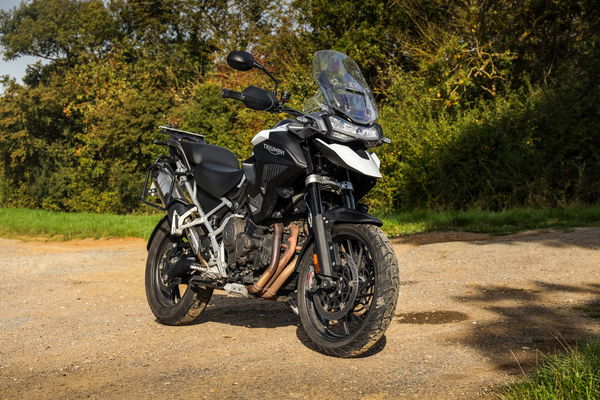Superbike group test 2017: GSX-R1000R vs Fireblade vs R1 vs ZX-10R vs S1000RR
Which is the best of the new crop of four-in-line litre sports bikes?
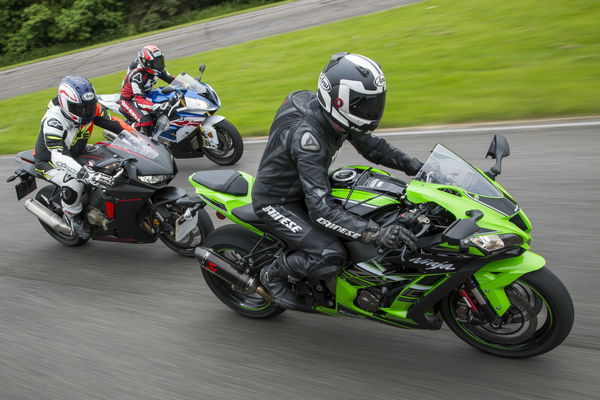
THE superbike class has been completely revitalised in the space of four years.
Back in 2014, it was looking a bit stagnant, with sales in decline and a shortage of major model developments.
Then Yamaha gave the market a big boot up the backside in 2015 with the new YZF-R1, featuring radical new electronics, not to mention styling.
BMW launched a comprehensively redesigned S1000RR the same year (although the old one was so good it barely needed to catch up).

Kawasaki answered with the heavily updated 2016 ZX-10R.
And now, finally, after making us wait so long we’d begun to wonder whether it would ever happen, Honda and Suzuki have answered with the new 2017 Fireblade and 2017 GSX-R1000R respectively.
All of which begs a question so obvious we don’t even need to tell you what it is. Let’s just get on with answering it, with our five-bike track test at Bruntingthorpe Proving Ground in Leicestershire…
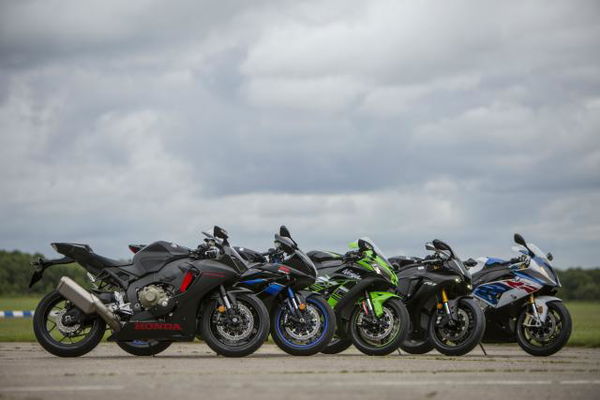
Engine
The S1000RR’s engine could be foremost among the various features which helped it dominate the class for so long. What it does so well is deliver astonishing performance with impeccable manners.
With stronger mid-range then the competition (at least until now) and a beautifully smooth power delivery, proving aggressive torque doesn’t have to be snatchy, it just makes it so easy for normal riders to go faster.
But it’s got a problem: it’s not the only one anymore. The ZX-10R is just as smooth and easily managed, although it perhaps doesn't deliver quite the torque below 7,000rpm.
More worringly for the S1000RR, the GSX-R1000 is just as smooth, controllable and user-friendly and feels even stronger in the mid-range. In a straight-line roll-on acceleration test, in from 40mph in fourth gear, the GSX-R didn’t just beat the BMW S1000 RR; it smashed it. We did it twice, just in case something had been amiss the first time, and it smashed it again.
It did the same to the new Blade, which itself didn’t feel at all lacking – strong, eager and just as manageable as the others.
The R1 feels slightly more aggressive than the rest. It’s also got good low-down torque and scorching top-end but the main source of the impression is the slightly rougher feel and sound of the crossplane crank engine, giving it a raw edge and making you feel more like you might be on an actual race bike.
Handling
The Blade is the pocket rocket of the five. It looks the smallest at first glance and it feels the smallest when you’re riding it, with a tiny screen that’s not much use at high speed and bars that feel closer to you than the other machines'.
So it’s easy to dominate – but it doesn’t have quite the reassuringly planted-feeling front-end of the ZX-10R, which feels bigger, the pay-off being a sense of stability.
Sometimes it’s nice to feel like you’re on something a little more substantial - for example when you’re passing 160mph and still accelerating, wondering how late you should brake for the approaching sharp right-hander – and the S1000RR delivers this too. It’s reassuring at extreme speeds with no evident compromise to agility.
Again here the R1 feels a bit more aggressive than the others, with a taller seat and stiffer, more race-bred feel. It takes a little longer to settle into than the others but once you're there, you're there.
All the machines can do that for you: let you forget about everything except where you want the bike to go.
But it’s the GSX-R that stood out as the one to do it almost from the moment it turned a wheel, is if I’d already had time to acclimatise to it. Although it possibly doesn’t have quite the planted feel of the ZX-10R, it seems so sharp-steering and compliant you can almost think it where you want it to go.
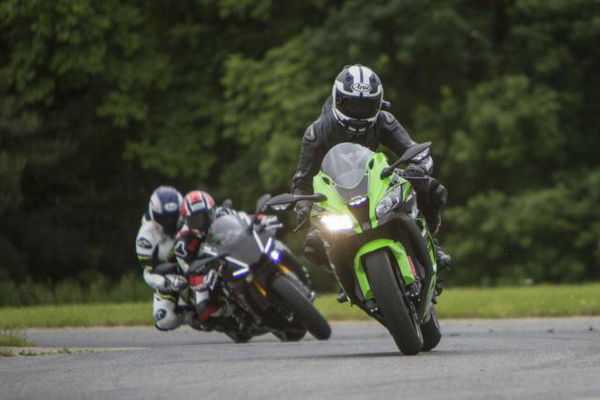
Suspension
All the bikes coped well with Bruntingthorpe’s bumpy surface.
The R1, with fully-adjustable KYB components, and the ZX-10R, with Showa Balance Free shock and forks, both seemed a little stiffer than the others. The Kawasaki in particular felt taut over some of Bruntinthorpe’s bumby corners. The GSX-R, also with Showa Balance Free Components, and S1000RR, with optional semi-active suspension, seemed less inclined to try to unseat me, as did the Blade, with fully-adjustable Showa Big Piston forks and Balance Free Rear Cushion shock.
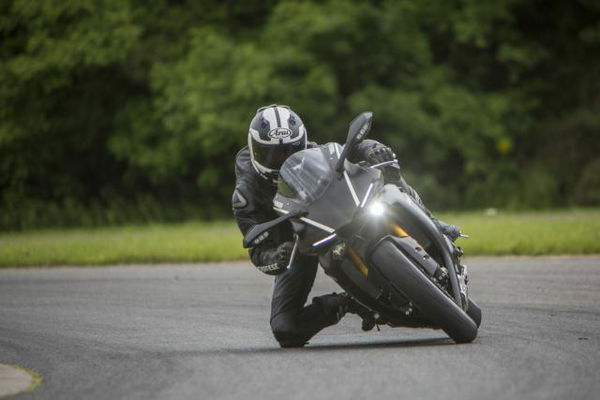
Brakes
Honda gave us the base-model Blade for this test (as opposed to the SP version), which doesn't have the semi-active Öhlins suspension or Brembo brakes of higher-spec versions. Its Tokico brakes just weren’t up to the standard of the rest of this crowd, needing to be worked much harder for equivalent stopping force.
The R1’s monbloc calipers felt much more powerful, and the other three bikes’ more powerful and controllable still.
Again, I think GSX-R stood out ahead slightly here, its Brembo set-up delivering precise and immense force in response to an effortless two-fingered pull on the lever
Equipment
All these bikes have riding modes plus lean-angle-sensitive multi-level traction control. The ZX-10R, GSX-R and Blade have lean-angle-sensitive ABS, while cornering ABS is an option on the S1000RR.
The higher-spec Sport version of the S1000RR also has semi-active suspension and an up/down quick-shifter (featured on the one we rode).
The R1 has an anti-wheelie function, a launch control system for race starts, and a unified brake system, obviously with ABS.
And the GSX-R has Suzuki's single-press ‘Easy Start’ ignition button. Don’t forget that.
Actually do forget it, because the thing that really separated the bikes in this test was none of the above. It was the quick-shifters, or lack thereof.
The absence of one on the base-model Blade hampered it in this group, where all the other bikes have one. When I rode it, I sometimes found myself looking for a quick-shifter that wasn’t there, and I was conscious of the extra time taken by gear changes.
The R1 and ZX10-R have a quick-shifter for upshifts, both of which work well.
The S1000RR we rode was equipped with one for up and down-shifts, which worked better on the way up than down, where the change could come with a jolt.
The GSX-R had one for up and down which worked like no quick-shifter I’ve ever tried before. It was almost seamless and instant on the way up, but the real revelation was the down-shifts, delivered so smoothly you’d barely know you were doing them.

We like
That GSX-R quick-shifter. It’s one of those things you don’t know you want until you try it, and then you need. It kept bike so much more settled for corner entry than I could ever manage otherwise. It almost removes gear changes from the many things to think about while riding a litre sports bike on track, transforming it into a 200hp twist-and-go and freeing some of your brain to focus on being better at the rest of the job.
We don't like
A couple of other things about the Blade. It was more prone than the others to back-torque on aggressive down-shifts, causing the rear to lock sometimes on the approach to a corner and making for a more unsettled entry.
And the seat is slippery. There’s more of a tendency to slide backwards on it under hard acceleration and a greater need to grip the tank, something you don’t need to focus on so much on the others, which better keep you in position.
CLICK NEXT FOR THE VERDICT
Pictures by Tom Rayner
These are all devastatingly effective sports bikes; a bit of time to settle into any one of them is all that's needed to feel right at home, in the zone, on the machine for you.
You could spend a month getting to know them all and not be sure which you love the best.
That’s what I was beginning to think towards the end of this test.
Then, for the final 10 minutes on track I tried the GSX-R again and realised, no: this was the one.
I’ve never ridden a superbike that makes the job so easy. So smooth, composed, compliant, so able to make controlling 200hp feel like second nature. I could spend a month on them all, but I think this is the one I’d be going fastest on, both on day one and day 30.
The S1000RR remains a staggeringly good machine and the R1 has a special, race-derived feel but second place goes to the ZX-10R. As on the GSX-R, I felt instantly, intuitively at home on it, with its controllable power delivery and assured handling.
However, if there was ever any doubt, the GSX-R’s quick-shifter nailed it for Suzuki. It’s the making of an already brilliant machine.
Maybe the result would have been different if Honda had given us the £19k SP version of the Blade but that’s a matter for another test.
CLICK NEXT FOR A SECOND OPINION ON ALL THE BIKES FROM VISORDOWN ROAD TESTER ALAN DOWDS
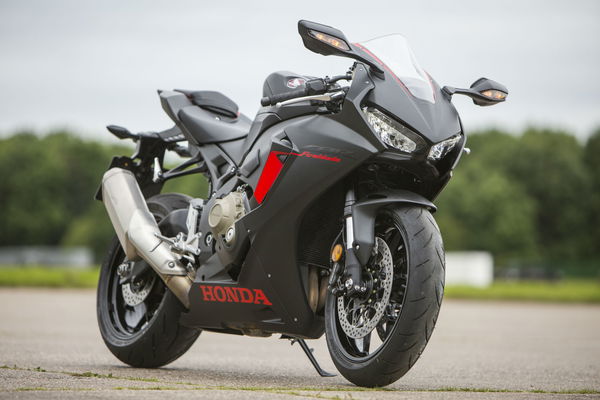
Honda Fireblade
After spending a fortnight and nearly 1,000 miles on the SP version, this was a teeny bit of a let down. Main grumble is the lack of quick-shifter – a good one is a real asset nowadays, especially on track, and not having one is much more of a faff than you might think. The base suspension isn't a massive let-down in isolation, but is much less capable than the Öhlins kit on the SP. Finally, it looks a bit plain in the matt black I reckon. Disappointing in the roll-on acceleration tests too – it is much slower to get going than the GSX-R in particular.
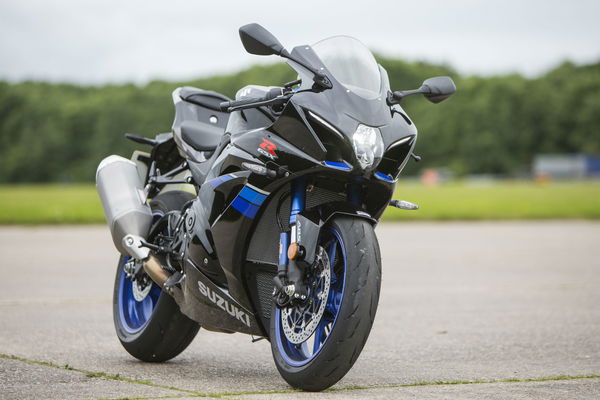
Suzuki GSX-R1000R
The opposite situation here – I'd spent a fortnight on the base GSX-R earlier this month, and so this fancy one was an upgrade! The quick-shifter is excellent, on par with the best out there, and the posh gas forks and higher-spec rear shock do give that higher-quality feel and plush action. The rest of the bike is much the same – I didn't notice a big difference from the leaning ABS for example. Quibbles? Reversing the monochrome dash and calling it a feature is cheeky – for my £16k I'd want a colour dash – if you can get a killer TFT panel on a £100 Chinese tablet, wtf not on a £16k motorbike?
It's all rendered moot by the motor though, which is a total hero on the road. Feels like a bigger engine thanks to the VVT – although I suspect there's lower gearing compared with the others too.
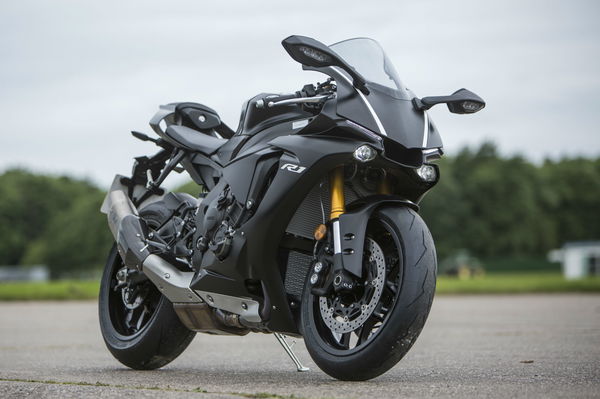
Yamaha R1
A sign of the fast-moving class that this now seems a little long in the tooth – but it's a corker still. The standout is the big bang motor of course, and both the sound and the torquey delivery are utterly gorgeous. It feels more like a race bike – the bars are closer together, it's taut and tall, and is slightly more daunting than the GSX-R or Blade at first on track. Get into it though, and the rewards are manifest. It's pricey, but there's a lot of tech for the cash. Needs a full-beans up-and-down quick-shifter really.
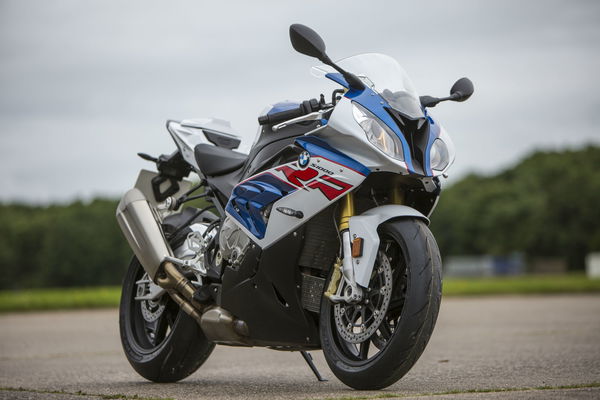
BMW S1000RR
Still incredible after all these years – the S1000 is a monster in all areas – yet utterly placid and usable too. Brakes are super-sharp, and the motor is fab everywhere. The quickshifter is a bit mushy on down-shifts, but fine on up-changes. I love all the toys – heated grips and cruise control would make day-to-day much easier on the BM – and it's fairly comfy and spacious too. Almost a bargain (until you hit the options list haha). You'd be well happy with one of these, no matter what your litre bike needs I'd say.
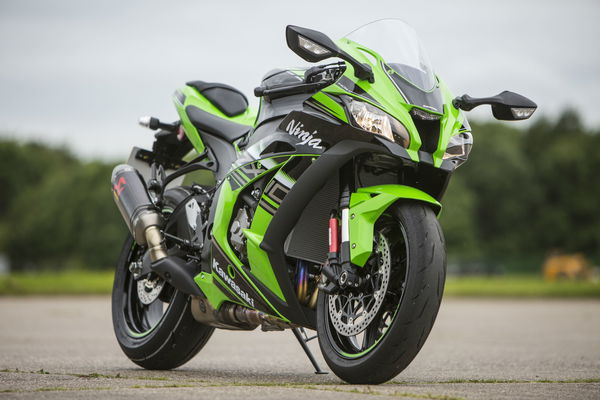
Kawasaki ZX-10R
A fearsome bike with a fearsome reputation – and a WSB winning record to die for. The Ninja is nuts, with a wild, power-packed engine, sharp brakes, and a chassis that just eggs you on to go faster and faster. My first session at Brunters was on this, and I was pissing myself laughing after two laps. 180mph in a blink down the big straight, lights flashing like a shit rave all over the dashboard, riding hard is a life-affirming, high-adrenaline rush on this bike. The motor is fab, if a bit frantic for day-to-day use I’d imagine, the suspension did a great job on the bumpy surface here, and the electronics didn't get in the way at all. Again, it needs a quickshifter upgrade to get on par with the Suzuki, and the grey LCD dash with idiot lights all over is a bit 2005.
CLICK NEXT FOR PRICES AND SPECS

Model tested: Honda CBR1000RR Fireblade
Price: £15,225 (£19,125 for SP version)
Engine: 999cc in-line four
Power: 191hp @ 13,000rpm
Torque: 86lbft @ 11,000rpm
Kerb weight: 196kg
Fuel capacity: 16 litres
Seat height: 832mm
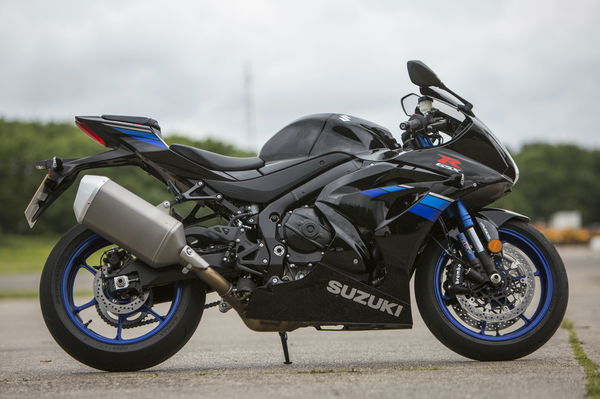
Model tested: Suzuki GSX-R1000R
Engine: 1000cc in-line four
Price: £16,099 (standard GSX-R1000 £13,249)
Power: 202hp
Torque: 86.7lbft
Kerb weight: 203kg (standard GSX-R1000 202kg)
Tank capacity: 16 litres
Seat height: 825mm
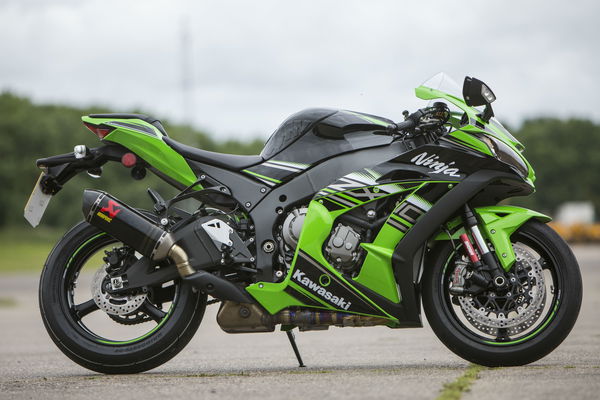
Model tested: Kawasaki Ninja ZX-10R
Price: from £14,149 (RR version £16,249)
Engine: 998cc in-line four
Power: 200hp @ 13,000rpm
Torque: 83.7lbft @ 11,500rpm
Kerb weight: 206kg
Tank capacity: 17 litres
Seat height: 835mm
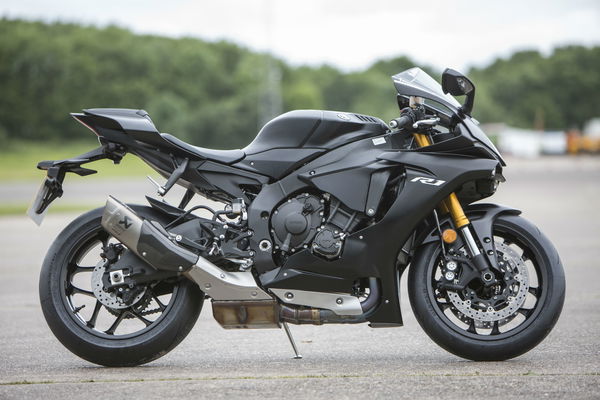
Model tested: Yamaha YZF-R1
Engine: 998cc in-line four
Price: £15,799
Power: 200hp @ 13,500rpm
Torque: 83lbft @ 11,500rpm
Kerb weight: 199kg
Tank capacity: 17 litres
Seat height: 855mm

Model tested: BMW S1000RR Sport
Engine: 999cc in-line four
Price: from £14,930 (standard RR £13,950)
Power: 199hp @ 13,500rpm
Torque: 83lbft @ 10,500rpm
Kerb weight: 204kg (full tank)
Tank capacity: 17.5 litres
Seat height: 815mm

